Контрольные вопросы о Испании
Охарактеризуйте современное географическое и геополитическое положение Испании, ее административное и государственное устройство. Дайте характеристику природных условий страны; сравните природные условия севера, центра и юга страны. Перечислите полезные ископаемые и покажите на карте места их залегания. Покажите на карте места проживания испанцев, галисийцев, басков и каталонцев. Охарактеризуйте демографическую и возрастную структуру населения Испании. Дайте краткую характеристику […]
Туризм и достопримечательности Испании
Туризм в Испании — это одна из наиболее важных отраслей экономики. В сфере туризма занято 1,5 млн жителей. В 2016 г. страну посетило 75,6 млн чел. (третье место в мире после Франции и США), доход от туристической деятельности составил €60,3 млрд. Популярна Испания и у россиян (до 1 млн чел. ежегодно). Самой большой популярностью у граждан […]
Транспорт Испании
Для Испании характерна радиальная конфигурация транспортной сети с центром в Мадриде. В стране развиты все виды транспорта, за исключением внутреннего водного (речного). Ведущая роль в пассажиро- грузоперевозках принадлежит автомобильному транспорту. По автодорогам осуществляется 90 % пассажирских и почти 80 % грузоперевозок. Протяженность автомобильных дорог составляет 683,2 тыс. км. На важнейших направлениях построены скоростные автострады — […]
Рыболовство Испании
В прибрежных водах Испании обитают разнообразные представители морской фауны. В атлантических водах промышляют сардин; в меньшей степени ловят мерлуз, бонито, анчоусов, салаку, треску и разнообразных моллюсков. Прибрежные воды Средиземного моря менее благоприятны для обитания ихтиофауны. Здесь наиболее распространены тунец, лосось, анчоусы, раки, лангусты и др. Главными районами морского промысла являются Северо-Восточная и Центральная Атлантика, Бискайский […]
Сельское хозяйство Испании
Испания располагает относительно благоприятными географическими и климатическими условиями для развития многоотраслевого сельскохозяйственного и агропромышленного производства. Потенциал сельского хозяйства оценивается достаточно высоко также и с учетом исторического и социально-экономического развития страны. До начала 1950-х гг. аграрный сектор был главным источником доходов государства. В настоящее время его доля в ВВП страны составляет 2,2 % и в нем […]
Промышленность Испании
Основными отраслями промышленности являются: горнодобывающая промышленность, энергетика, пищевая и производство продовольствия, судостроение, автомобилестроение, металлургическая, металлообрабатывающая, химическая и текстильная. Важное место занимают также мебельная промышленность и производство керамических изделий. Горнодобывающая промышленность — старейшая отрасль экономики. В настоящее время добывается более двух десятков видов полезных ископаемых. Это железная руда, нефть, газ, кварц, пириты, медь, золото, олово, ртуть, […]
Общая характеристика хозяйства Испании
Испания — индустриально-аграрное государство, занимающее 5-е место в Европе по объему ВВП после Германии, Франции, Великобритании и Италии и 14-е — в мире. ВВП в расчете на душу населения по номиналу и средний размер заработной платы — 27-е место в мире, ИЧР — очень высокий (26-е место), ИГН — невысокий (15-е место), международный индекс счастья […]
Население Испании
Испания — многонациональное государство. Основу населения составляют четыре народа — испанцы, каталонцы, галисийцы и баски, чьи языки, кроме бакского, относятся к романской группе индоевропейской языковой семьи. Баскский язык считается изолированным языком, происхождение которого до конца не выяснено. Испанцы, которых 3/4 численности населения, проживают на свыше 80 % территории страны. Галисийцы обитают в северо-западных провинциях, баски […]
Полезные ископаемые Испании
Недра Испании богаты рудными полезными ископаемыми, в то же время очень бедны топливными ресурсами — нефтью и природным газом. Рудные полезные ископаемые широко распространены по всей территории страны особенно в горных районах. По суммарным запасам рудного сырья выделяются железные руды (1,45 млрд т). Месторождения железных руд открыты в провинциях Бискайя, Гранада, Леон, Теруэль, Сантандер, Альмерия, […]
Природные условия Испании
Природа Испании отличается значительным своеобразием. Это связано прежде всего с обособленностью Пиренейского полуострова от остальной Европы и с близостью Африканского континента, оказывающего на его природные условия большое влияние. Около 90 % территории страны составляют плоскогорья и горы. Почти половину поверхности испанского государства занимает самое большое в Европе плоскогорье — Месета (по-испански — стол) со средней […]

Географическое положение и административное устройство Испании
Испания — третье по площади государство в Европе. Протяженность с севера на юг составляет 870 км, с востока на запад — 1000 км. Страна занимает большую часть Пиренейского полуострова, Балеарские и Питиузские острова в Средиземном море и Канарские острова в Атлантическом океане. В состав Испании входят города Сеута и Мелилья на северном побережье Африки с […]
Контрольные вопросы о Италии
Охарактеризуйте современное географическое и геополитическое положение Италии, ее административное и государственное устройство. Дайте характеристику природных условий страны; сравните природные условия севера и юга страны. Перечислите полезные ископаемые и покажите на карте места их залегания и разработки. Охарактеризуйте современное население Италии. Покажите на карте места проживания итальянцев и основных национальных меньшинств, а также крупнейшие города. Дайте […]
Туризм и достопримечательности Италии
Италия относится к числу наиболее посещаемых стран мира. В 2016 г. страну посетило 52,4 млн иностранных туристов (5-е место в мире). Доход от туризма составил €40,2 млрд. В Италии сосредоточено около 60 % культурных ценностей Европы. Практически каждый итальянский город представляет собой настоящий музей истории под открытым небом. При этом 53 объекта культуры и природы […]
Виды транспорта Италии
Италия располагает хорошо развитой транспортной сетью. Во внутренних перевозках грузов и пассажиров главную роль играет автомобильный транспорт (соответственно 80 и 90 %), на втором месте — железнодорожный. Особенно хорошо обеспечена автодорогами Северная Италия, где построена целая сеть скоростных автострад. Главная транспортная артерия страны — «Автострада Солнца», идущая с севера на юг — от Турина через […]
Рыболовство Италии
Несмотря на то что Италия с трех сторон омывается морями, рыболовство развито слабо. Это связано с тем, что прибрежные зоны не богаты рыбой из-за узости континентального шельфа, малого количества банок и отмелей. Половина всего улова, а это сардины, скумбрии, анчоусы, тунцы, а также моллюски и ракообразные, приходится на адриатическое побережье. Другая важная рыболовная зона — […]
Отрасли сельского хозяйства Италии
Доля сельского хозяйства в ВВП страны составляет 2,2 %. В нем занят почти 1 млн чел. Основная форма организации сельскохозяйственного производства — мелкие крестьянские хозяйства. Около 70 % хозяйств имеют площадь менее 5 га, особенно их много на юге страны. В то же время большая часть сельскохозяйственной продукции производится на средних и крупных агропредприятиях. Средние […]
Отрасли промышленности Италии
Одно из ведущих направлений экономики страны. Она дает около 25 % национального дохода, и в ней занято 27 % экономически активного населения. Это притом, что Италия слабо обеспечена сырьевыми и энергетическими ресурсами. Главная отрасль промышленности — обрабатывающая, ведущая роль в которой принадлежит машиностроению. В ряде отраслей обрабатывающей промышленности Италия достигла позиций мирового лидера, о чем […]
Сферы хозяйства Италии
Италия — экономически развитая индустриально-аграрная страна. По суммарному объему ВВП занимает 8-е место в мире и 4-е в Европе, внешнеторговому обороту — 9-е в мире. ВВП в расчете на душу населения по номиналу — 25-е место в мире, средний размер заработной платы — 21-е в мире, ИЧР — очень высокий (28-е место), ИГН — невысокий […]
Италия: население
По численности населения Италия занимает четвертое место в Европе после Германии, Франции и Великобритании. 94 % населения страны составляют итальянцы. 20 миллионов итальянцев проживает за рубежом, главным образом в США, Франции, Германии и Аргентине. Два народа — фриулы и родственные им по языку ладины — имеют статус национальных меньшинств. Они говорят на диалектах ретороманского языка. Фриулы […]
Полезные ископаемые Италии
Италия обладает разнообразными полезными ископаемыми, но их месторождения большей частью невелики, распылены по территории, нередко залегают неудобно для разработки. Добыча минеральных ресурсов на ряде месторождений ведется с античных времен, то есть уже более 2000 лет. Как следствие, многие из них сильно истощены и не имеют большого промышленного значения. До наших дней экономическое значение сохранили самородная […]
Природные условия Италии
Италия расположена на крайнем юге Европы. Почти 4/5 поверхности занимают горы и возвышенности, и менее 1/4 приходится на Паданскую низменность (равнина) и узкие приморские районы. Горы доминируют на севере, где располагается горная система Альп, высочайшие вершины которой покрыты мощными ледниками. Именно здесь находится самая высокая вершина страны — г. Монте-Роза (4634 м). Через всю страну […]
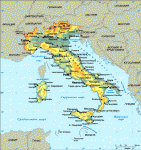
Географическое положение и административное устройство Италии
Италия — одна из древнейших стран мира и в то же время сравнительно молодое государство, появившееся на карте мира в 1871 г. после окончательного объединения на ее территории отдельных княжеств и герцогств. По площади занимает 9-е место в Европе и 69-е в мире. Большая часть страны расположена на Апеннинском полуострове. Италии также принадлежат два крупных […]
Контрольные вопросы о Франции
Охарактеризуйте современное географическое и геополитическое положение Франции; административное и государственное устройство Французской республики. Дайте характеристику природных условий страны; сравните природные условия атлантического побережья и средиземноморского юга. Перечислите полезные ископаемые Франции и покажите на карте места их залегания. Охарактеризуйте современное население Франции, его демографические составляющие. Покажите на карте места проживания национальных меньшинств — эльзасцев, бретонцев, фламандцев, […]
Туризм и достопримечательности Франции
Иностранный туризм является одной из важной составляющих сферы услуг. В 2016 г. страну посетило 82,6 млн туристов (первое место в мире), а доход от туристической деятельности составил €42,5 млрд (пятое место в мире)4. Туристов привлекают исторические и природные достопримечательности — старинные замки и церкви, курорты Лазурного берега, Бискайского залива, целебные воды Центрального массива, базы зимнего […]
Франция: транспорт, виды
Франция располагает развитой сетью железных и автомобильных дорог, большой протяженностью судоходных рек и каналов, трубопроводов. В стране много морских портов и аэропортов. Особенностью транспортной сети является радиальная конфигурация с центром в Париже. К столице сходятся важнейшие железнодорожные и автомобильные магистрали, трубопроводы, основные водные пути. Сеть железных дорог самая развитая в Европе. Французские железные дороги отличаются […]
Рыболовство Франции
Рыбный промысел имеет принципиальное значение для жителей приморских районов страны, и прежде всего северо-западного и северного побережий Франции. Тут находятся главные рыболовные порты, в частности, Булонь, на долю которого приходится 35 % общего улова рыбы. Крупными портами являются также Лорьян и Конкарно. Рыболовством занимаются чуть более 20 тыс. чел., а рыболовный флот насчитывает свыше 8 […]
Отрасли сельского хозяйства Франции
Франция — крупнейший производитель сельскохозяйственной продукции в Европе. На долю сельского хозяйства приходится 1,7 % ВВП. В нем занято 2,7 % самодеятельного населения страны, и оно дает более 17 % продукции аграрного сектора ЕС. Страна полностью обеспечивает себя основными видами продовольствия, за исключением экзотических овощей и фруктов. Поэтому уровень потребления продуктов питания в расчете на […]
Отрасли промышленности Франции
Во Франции развиты практически все базовые отрасли экономики. Наибольшего прогресса достигли электроэнергетика, черная металлургия, химическая, нефтехимическая, нефтеперерабатывающая, машиностроение, в том числе автомобиле- и судостроение, сельскохозяйственное машиностроение, военная промышленность, биоиндустрия, фармакология, авиакосмическая, легкая и пищевая, сельское хозяйство и сфера услуг. Горнодобывающая промышленность находится в кризисе. Из года в год отмечается сокращение добычи собственных полезных ископаемых за […]
Отрасли хозяйства Франции
Франция — высокоразвитая индустриально-аграрная страна, ядерная и космическая держава. По объему ВВП занимает 6-е место в мире и третье в Европе после Германии и Великобритании, а внешнеторгового оборота — третье в Европе. ВВП в расчете на душу населения по номиналу — 22-е место мире, средний размер заработной платы — 17-е место в мире, ИЧР — […]
Население страны Франции
Франция — страна до недавнего времени была сравнительно однородной в этническом отношении. После массового приема арабского и африканского населения доля французов начала сокращаться и в настоящее время составляет около 80 %. Однако при определении национального состава имеется некоторая сложность. Во французском политическом лексиконе не используется понятие «национальное меньшинство» и даже «национальность» в том смысле, как […]
Полезные ископаемые Франции
Недра Франции не содержат значительных запасов минерального сырья. Из имеющихся полезных ископаемых наибольшее значение имеют железные руды, бокситы, калийные и каменные соли, фосфориты, строительные материалы. Весьма ограничены топливные ресурсы, за исключением урана. Залежи каменного угля находятся на севере Франции, в Лотарингии и в Центральном массиве. Его общие запасы оцениваются в 600 млн т, извлекаемые — […]
Природные условия Франции
Почти половина территории страны — это равнины и низменности. Они занимают всю западную и северную части. Здесь расположены Северо-Французская, Гаронская и Верхне-Рейнская низменности. В центральных и восточных районах страны размещаются сильно разрушенные средневысотные массивы и возвышенности (Центральный Французский массив, Вогезы, Арденны). На юго-востоке и юго-западе вздымаются высокие горы, соответственно Альпы и Пиренеи. В Альпах, на […]
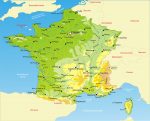
Географическое положение и административное устройство Франции
Франция, или Французская Республика — второе по площади государство Зарубежной Европы. Кроме материковой части, в ее состав входят Корсика и несколько других более мелких островов, расположенных в Средиземном море и Бискайском заливе. Франция имеет владения в Америке, Африке и Океании, оформленные в виде так называемых «заморских регионов и территорий»: Французская Гвиана, острова Гваделупа, Мартиника, Реюньон, […]
Контрольные вопросы о Великобритании
Охарактеризуйте современное географическое и геополитическое положение Великобритании, ее административное и государственное устройство и назовите историко-географические области. Расскажите о своеобразии природных условий страны. Назовите полезные ископаемые, имеющиеся в стране, и покажите на карте места их залегания и разработки. Перечислите древние народы, участвовавшие в формировании английской нации; современный национальный состав Англии, Шотландии, Уэльса и Северной Ирландии. Назовите […]
Туризм и достопримечательности Великобритании
Туризм в Великобритании является одним из ключевых секторов сферы услуг. В нем занято около 2 млн чел. В 2016 г. страну посетило 35,8 млн иностранцев, доход от туристической деятельности составил $39,6 млрд (8,9 % всех мировых доходов отрасли). Территория Великобритании полна природных контрастов — древние и унылые торфяники, вересковые пустоши и огромные озера Шотландии на […]
Великобритания: Транспорт
В Великобритании хорошо развита транспортная инфраструктура; территория страны покрыта густой сетью железных и автомобильных дорог. По густоте транспортных коммуникаций на 1000 км2 уступает только малым европейским странам. Островное положение предопределяет лидирующую роль морского транспорта. По данным Министерства транспорта и Судоходной палаты Великобритании, около 95 % тоннажа и 75 % стоимости британских внешнеторговых грузов, а также […]
Рыболовство Великобритании
Великобритания относится к рыболовным державам Европейского Союза (четвертое место в ЕС). Ежегодно вылавливается от 750 тыс. т до 800 тыс. т рыбы. Основной промысел рыбы ведется на северо-востоке Шотландии, вблизи от богатых рыболовных районов Северного моря и севера Атлантического океана. Важнейшее промысловое значение имеют треска, скумбрия, сельдь и путассу. Вылавливают также угольную рыбу, кильку, сардины, […]
Великобритания: Сельское хозяйство
Сельское хозяйство Великобритании одно из самых продуктивных и механизированных в мире. Его доля в ВВП страны составляет менее 1 %. В стране существует 240 тыс. фермерских хозяйств, на которых трудится более 500 тыс. чел. Практически вся земля обрабатывается фермерами. Фермы в Великобритании в среднем крупнее, чем в других странах Европы. Средняя площадь земель, занимаемых одной фермой, […]
Великобритания: Промышленность
Процесс концентрации производства в промышленности привел к созданию крупнейших объединений промышленников. Небольшое число огромных компаний контролирует в них практически все производство. Самые крупные промышленные монополии страны — Imperial Chemical Industries, или ICI, Unilever, British Leyland и General Electric, в каждой из которых занято по 200 тыс. человек. Всего в стране насчитывается 21 компания, входящая в […]
Великобритания: Общая характеристика хозяйства
Великобритания — высокоразвитое индустриальное государство. По суммарному объему ВВП, уровню экономического развития занимает второе место в Европе (после Германии) и пятое — в мире. Объем ВВП в расчете на душу населения по номиналу — четвертый в мире, средний размер заработной платы — 12-е в мире, ИЧР — очень высокий (14-е место), ИГН — невысокий (25-е […]
Великобритания: Население
Самым древним населением Британских островов, о котором есть сведения, были иберы, прибывшие сюда с Пиренейского полуострова в 2500—2000 гг. до н. э. Примерно в 1000 г. до н. э. из северных районов современных Франции и Бельгии переселились кельты, которые постепенно заняли все Британские острова, ассимилировав или истребив прежнее население. Свой след оставили и римляне, господствовавшие […]
Полезные ископаемые Великобритании кратко
На территории Великобритании нет большого разнообразия полезных ископаемых, однако некоторые из них сыграли огромную роль в формировании ее промышленных районов. Особенно богаты месторождения каменного угля, общие запасы которого оцениваются в 230 млрд т, а извлекаемые — в 3,3 млрд т. Эти запасы рассредоточены по территории Англии, Уэльса и Шотландии. Крупнейшие угольные бассейны: Шотландский, Южно-Уэльсский, Нортумберлен-Даремский, Канберлендский, […]
Природные условия Великобритании
По природным условиям Великобритания во многом сходна с соседними странами Западной Европы. В то же время островное положение, близость теплого Северо-Атлантического течения, сильная расчлененность береговой линии наложили определенный отпечаток на природу этой страны. Чуть больше половины территории государства занимают горные районы. Горный рельеф доминирует в Шотландии (Северо-Западное нагорье, Грампианские горы, Южно-Шотландская возвышенность), на севере Англии […]
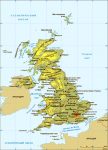
Географическое положение и административное устройство Великобритании
Государство Великобритания или, как его называют официально, Соединённое Королевство Великобритании и Северной Ирландии, расположено на Британских островах у северо-западных берегов континентальной Европы. Британские острова — самый обширный архипелаг в Европе. В него входят два больших острова — Великобритания и Ирландия, разделенные Ирландским морем, и еще 5 тыс. мелких островов, среди которых особо выделяются три группы […]
Контрольные вопросы о Германии
Охарактеризуйте современное географическое и геополитическое положения. Назовите административные единицы (федеральные земли) Германии. Перечислите крупные географические области страны и дайте их краткую природную характеристику. Перечислите полезные ископаемые Германии и покажите на карте места их добычи. Дайте краткую характеристику населения ФРГ. Покажите на карте места проживания национальных меньшинств страны. Дайте развернутый обзор экономического развития Германии с послевоенного […]
Туризм и достопримечательности Германии
Германия относится к числу ведущих туристических держав Европы. В 2016 г. страну посетило 35,6 млн человек (7-е место в мире), а доход от туризма составил €33,3 млрд. В туристическом секторе трудится 2,2 млн чел. Туристов привлекают ухоженная долина Рейна с множеством средневековых замков и монастырей, древняя культура Баварии и великолепие предгорий Баварских Альп, живописный Шварцвальд, […]
Транспорт Германии
Германия располагает развитой транспортной инфраструктурой, занимает одно из первых мест в мире по густоте транспортных путей. В стране развиты все виды транспорта. В связи с большой интенсивностью экономических отношений с партнерами по ЕС и центральным положением в Европе в общем грузообороте всех видов транспорта велика доля трансграничных перевозок (более 40 %). Автомобильный транспорт Ему принадлежит […]
Рыболовство Германии
В Германии хорошо развитая рыбная промышленность, которая имеет большое значение для экономики страны. По объемам добычи рыбы (278 тыс. т) и аквакультуры (26,9 тыс. т, 2015 г.) немецкая рыбная отрасль находится на 7—8-м месте среди стран — членов ЕС. Ее продукцию покупают как внутри страны, так и во Франции, Италии, Австрии и странах Бенилюкса. В […]
Германия: cельское хозяйство
Сельское хозяйство относится к числу значимых отраслей экономики, даже несмотря на то, что его доля в ВВП страны составляет менее 1 %, а число занятых в нем немногим более 1 млн чел. Страна на 90 % удовлетворяет свои потребности в продовольствии, значительная часть его поставляется на экспорт. В 2016 г. экспорт сельскохозяйственной продукции составил $52 […]

Германия: промышленность
Германия относится к числу немногих государств мира, где развиты практически все основные отрасли экономики. Наибольшего развития достигли электроэнергетика, черная металлургия, машиностроение, в том числе автомобильная промышленность, судостроение, электронная и электротехническая, авиакосмическая, химическая, нефтеперерабатывающая, легкая и пищевая, сельское хозяйство и сфера услуг. Энергетика. Германия — крупнейший производитель электроэнергии в Европе — 654,2 млрд кВт ч (первое место […]
Германия: общая характеристика хозяйства
Современная Германия — одно из наиболее развитых государств мира. По объему ВВП по номиналу занимает четвертое место в мире, уступая только США, Китаю и Японии, а внешнеторгового оборота — третье. ВВП в расчете на душу населения по номиналу — 17-й мире, средний размер заработной платы — 8-й в мире, ИЧР — очень высокий (5 место), […]
Население Германии
По числу жителей Германия занимает первое место в Европе. Подавляющее большинство (92 %) — немцы. Кроме немцев из коренных народов на востоке страны проживают лужицкие сербы (60 тыс.), на севере — датчане, северо-западе — голландцы (каждых примерно по 50 тыс.). Эти три народа относятся к национальным меньшинствам. Много иностранцев — около 7 млн, в том числе […]
Полезные ископаемые Германии
Германия располагает небольшим набором полезных ископаемых. Наибольшее значение имеют топливно-энергетические ресурсы и прежде всего каменный и бурый угли. Основные месторождения каменного угля находятся в западной части страны (Рурский, Саарский и Ахенский бассейны). Эти угли высокого качества, свыше 2/3 — коксующиеся. Суммарные запасы каменного угля оцениваются в 125 млрд т, бурого — 54,5 млрд т. Достоверные […]
Природные условия Германии
Природа Германии по-своему интересна и привлекательна. При протяженности с севера на юг почти на 900 км и с запада на восток на 640 км представлено как минимум пять крупных типов ландшафтов совершенного различного характера, входящих в состав четырех крупных географических областей. Север страны — это Северо-Германская низменность, омываемая водами Северного и Балтийского морей. Прибрежная зона […]
Географическое положение и административное устройство Германии
Германия — государство, расположенное в Западной Европе. Ее соседями являются девять стран: на севере — Дания, на западе — Нидерланды, Бельгия, Люксембург и Франция, на юге — Австрия и Швейцария, на востоке Польша и Чехия. В современных границах Германия образовалась в 1990 г. путем слияния Федеративной Республики Германия (ФРГ), созданной в 1949 г. на основе […]
Контрольные вопросы о Зарубежной Европе
Охарактеризуйте современную политическую карту Европы. Перечислите регионы Европы, назовите страны, входящие в Европейский Союз и СНГ; причины создания ЕС и СНГ. Назовите основные наднациональные институты ЕС и перечислите их функции и полномочия. Охарактеризуйте своеобразие природных условий в региональном разрезе: рельеф, климат, почвенно-растительный покров, животный мир. Дайте определения понятий «маквис», «гаррига», «фригана». Назовите важнейшие полезные ископаемые, […]

Туризм и достопримечательности Зарубежной Европы
Европа — наиболее важная в туристическом отношении территория земного шара. Здесь возникли первые очаги туризма в древнем мире, здесь зародился организованный туризм в XIX в., здесь находятся и наиболее посещаемые туристами государства. И это не случайно: Европа — очень разнообразная по природным особенностям территория — от зон холодного и умеренного пояса, до популярных в туризме субтропиков […]

Транспорт Зарубежной Европы
Транспортная сеть Европы характеризуется густотой коммуникаций и высокой плотностью движения транспорта. Велика роль региона в международных и транзитных перевозках, но по дальности перевозок она намного уступает транспортным системам США и России, но по уровню технического развития находятся на одном из первых мест в мире. Особенно это относится к странам, входящим в Европейский Союз. Развитию транспортных […]

Рыболовство Зарубежной Европы
В странах Европы преобладает морское рыболовство. Ежегодно в морях и океанах вылавливается от 10 до 12 млн т рыбы, добывается около 3 млн т аквакультуры, порядка 125—130 тыс. т рыбы вылавливается из внутренних водоемов (реки и озера). Внешнеторговый оборот рыбной продукции превышает $90 млрд. Крупнейшими рыболовными державами являются Испания, Исландия и Норвегия. На эти страны […]

Сельское хозяйство Зарубежной Европы
Земельный фонд насчитывает свыше 500 млн га. Под нужды сельского хозяйства только в странах ЕС используется более 170 млн га земли. Под пашней занято около 105 млн га, а всего в обработке находится 115 млн га. По степени распаханности территория Европы занимает первое место среди прочих частей света. При этом земледельческое освоение территории европейского субрегиона […]

Промышленность Зарубежной Европы
Зарубежная Европа — один из ключевых центров в мировом хозяйстве по размерам промышленного производства и экспорту промышленных товаров. На ее долю приходится около трети мировой промышленной торговли. В структуре отраслей ведущие позиции занимают современные наукоемкие производства: атомная энергетика, энергетическое хозяйство, автомобильная, авиационно-космическая, электротехническая промышленность, роботостроение, новейшие отрасли химии, электроника, ряд секторов легкой и пищевой промышленности. […]
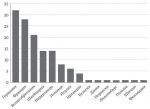
Общая характеристика хозяйства Зарубежной Европы
После Второй мировой войны национальные хозяйства большинства европейских стран, прежде всего восточноевропейских, были сильно разрушены. При этом западная часть Европы оказалась в экономической, политической и военной зависимости от США, центральная и восточная части — Советского Союза. Поэтому в американской и советской зонах раздела Европы сложились разные общественно-политические формации. Западноевропейские страны в экономическом отношении оказались в […]

Население Зарубежной Европы
Первые поселения человека появились на юге и в центре Европы. Это произошло примерно 400—30 тыс. лет назад. Самые ранние очаги высокой цивилизации зародились в III—II тыс. до н. э. Эта была эгейская культура, на смену которой впоследствии пришла греческая. Долгое время греческий язык был главным языком культурного общения в Восточном Средиземноморье и на Ближнем Востоке. […]
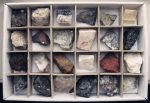
Полезные ископаемые Зарубежной Европы
Зарубежная Европа богата каменным и бурым углями, природным газом, железными и полиметаллическими рудами, ртутью, калийными солями, графитом и баритом. В то же время европейские страны испытывают недостаток в таких важнейших видах минерального сырья, как нефть, природный газ, марганцевые и никелевые руды, хромиты, фосфатное сырье, олово, медь, уран, бокситы и др. Топливно-энергетические ресурсы По суммарным запасам […]
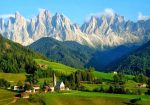
Природные условия Европы
Зарубежная Европа отличается разнообразием рельефа, большим влиянием морей и океанов и мозаичностью ландшафтов. В орографическом отношении представляет собой четыре крупных пояса, последовательно сменяющихся с севера на юг: плоскогорья и возвышенности Скандинавии (Скандинавское плоскогорье и Скандинавские горы), Среднеевропейская равнина, среднегорья Западной и Центральной Европы (Центральный Французский массив, Северо-Шотландское нагорье, Ленинские и Кембрийские горы), альпийские высокогорья (Альпы, […]
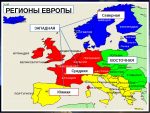
Регионы Европы
Западная Европа Самый маленький по площади, но самый заселенный регион Европы. В его состав входят 8 государств, охватывающих территорию от германских низменностей на востоке до Бискайского залива на западе и берегов Средиземного моря на юге. Подавляющая часть населения говорит на языках германской группы. Общая численность населения превышает 190 млн чел. Господствующая религия — христианство. Имеются […]
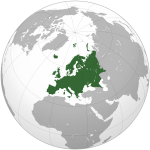
Зарубежная Европа — Формирование современной политической карты
Зарубежная Европа (далее Европа) расположена в западной части континента Евразия. Ее восточной границей является современная граница России. Европа — один из тех регионов мира, который определяет экономическое и политическое развитие человечества. Ее вклад в мировую цивилизацию несомненен и длителен, начиная с эпохи Древней Греции и Древнего Рима. В современном понимании Европа — это очаг западной […]
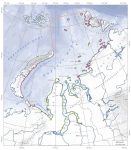
Геолого-геоморфологические условия Карского моря
Современные донные осадки Основным источником поступления обломочного материала в Карское море в ходе послеледниковой трансгрессии и в современных условиях являются речной сток и продукты размыва берегов и подводного берегового склона. Ежегодно в море поступает 56,7 млн т терригенного материала, перераспределяющегося в пределах шельфа в соответствии с циркуляцией вод и дрейфом льдов. Обско-Енисейское стоковое течение ежегодно […]
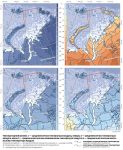
Климат Карского моря
Климат Карского моря — холодный, полярный. Зима в Карском море продолжительная и холодная. Температура воздуха ниже 0 °С сохраняется на севере 9–10 месяцев, на юге 7–8 месяцев. Средняя температура воздуха в январе –20, –28 °С (минимальная наблюденная температура на метеостанции м. Стерлигова –48,3 °С), в июле 1–6 °С (максимальная до 25 °С там же). Климатические […]
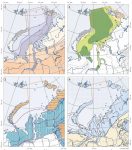
Физико-географическая характеристика Карского моря
Карское море расположено в Северном Ледовитом океане у берегов Сибири и относится к типу материковых окраинных морей. Его морские границы с Арктическим бассейном и Баренцевым морем в определенной степени условны. Западная граница Карского моря проходит от м. Кользат (81°01′ с. ш., 65°22′ в. д.) до м. Желания (76°57′ с. ш., 68°35′ в. д.), затем вдоль […]
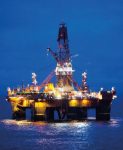
Исследования ПАО «НК «Роснефть» в Карском море
ПАО «НК «Роснефть» начало изучение гидрометеорологических, ледовых и инженерно-геологических условий на лицензионных участках арктического шельфа в 2012 году. По состоянию на конец 2015 года проведено 10 научно-исследовательских экспедиционных работ: одна — в 2012 г., две — в 2013 г., три — в 2014 г., четыре — в 2015 г., среди которых самая масштабная по объему […]

История научных исследований в Карском море в XIX–XX веках
Добравшись в своих промысловых экспедициях до Новой Земли и пройдя проливы, русские поморы встретились с Карским морем. Это было задолго до того, как в 1597 году Виллем Баренц прошел Югорский Шар и зазимовал на берегу Карского моря. Опыт поморских полярных путешествий стал основой для планирования исследований побережья Карского моря. Одно за другим появляются документированные описания […]
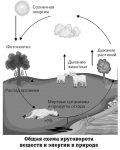
Биосфера – живая оболочка Земли
Биосферой называется оболочка Земли, населенная живыми существами. Биосфера включает в себя верхнюю часть литосферы, всю гидросферу и нижнюю часть атмосферы (до озонового слоя). Верхняя граница биосферы условна. Микроорганизмы могут заноситься с восходящими потоками воздуха на большие высоты, но выше озонового слоя органической жизни в принципе быть не может, поскольку там присутствует во всей полноте коротковолновая […]
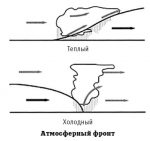
Погода и климат, типы климата. Климатические пояса
Температура и влажность воздуха, атмосферное давление, облачность, осадки и ветер определяют погоду – физическое состояние нижнего слоя атмосферы в той или иной точке пространства в определенный момент времени. Погода изменчива. Ее изменение зависят от изменений отдельных характеристик – температуры и влажности воздуха, атмосферного давления, облачности, характера и количества осадков, скорости и направления ветра. Изменение погоды […]
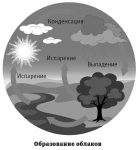
Водяной пар в атмосфере. Атмосферные осадки
Вследствие испарения воды с поверхности океанов и прочих водоемов в тропосфере всегда присутствует водяной пар. Испарение зависит от температуры воздуха, наличия и скорости ветра, характера рельефа, растительного покрова и цвета почвы (темная почва интенсивнее поглощает солнечное излучение, сильнее нагревается и интенсивнее испаряет воду). Ветер имеет очень важное значение для испарения, поскольку он постоянно заменяет насыщенный […]
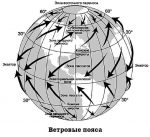
Циркуляция атмосферы
Перепады атмосферного давления вызывают перемещение воздуха из области высокого давления в область низкого. Горизонтальное движение воздуха относительно земной поверхности называется ветром. Направление ветра определяют по той стороне горизонта, откуда он дует. Обратите внимание – «откуда», а не «куда»! Северный ветер дует с севера на юг, а не с юга на север. Для определения направления ветра […]
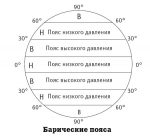
Атмосферное давление
Воздух имеет массу, пусть и небольшую. Масса 1 л воздуха на уровне моря равна 1,3 г. Но огромный объем земной атмосферы приводит к тому, что на каждый квадратный сантиметр земной поверхности атмосфера давит с силой, равной 1 кг! Это среднее давление воздуха над уровнем океана у широты 45° при температуре 0 °C принято за нормальное […]
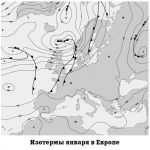
Температура воздуха. Нагрев атмосферы
Температура воздуха – одна из основных характеристик погоды, широко употребляемая и хорошо изученная. Температуру воздуха измеряют в тени на высоте 2 м от земной поверхности. Для измерения температуры используют термометры. Географы оперируют понятиями среднесуточной, среднемесячной и среднегодовой температуры. На географических картах распределение температур изображают изотермами – линиями, соединяющими точки с одинаковой температурой. Обычно используются понятия […]
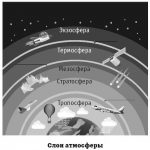
Слои атмосферы
Тропосфера, как самый близкий к земной поверхности слой атмосферы, содержит 80–90 % массы всей атмосферы нашей планеты и почти весь водяной пар. Температура тропосферы с увеличением высоты понижается (на 6 °C на на каждый километр подъема). В тропосфере в основном формируется погода, возникают циклоны и антициклоны, образуются облака, осадки, туманы, ветры. Ветры представляют собой горизонтальные […]
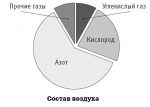
Состав и строение атмосферы
Атмосферой называют газовую оболочку нашей планеты. Наука, изучающая атмосферу Земли и происходящие в ней процессы, называется метеорологией. Атмосфера удерживается около Земли благодаря силе тяжести. Вместе с Землей атмосфера принимает участие в суточном и годовом вращении. Масса атмосферы составляет одну миллионную долю массы земного шара и примерно равна 5,3 х 1015 тонн. Атмосферный воздух представляет собой […]

Гидросфера
Гидросфера – это водная оболочка Земли, включающая всю воду на планете. Объем гидросферы составляет около 1,5 миллиардов км2 воды и примерно 96 % от этого объема приходится на соленые воды океанов и морей. Мировой Океан Мировой океан занимает площадь около 361 миллиона км2, что составляет примерно 71 % от площади поверхности нашей планеты. В Южном […]
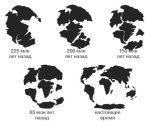
Строение Земли. Земная кора и литосфера
Наука, изучающая внутреннее строение, состав и историю развития Земли, называется геологией. В переводе с греческого «геология» означает «наука о Земле». Но если сказать точнее, то геология изучает не всю Землю, а только земную кору – самый верхний слой нашей планеты. До более глубоких слоев человек пока еще не добрался и все знания о них строятся […]
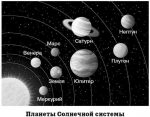
Земля планета Солнечной системы
Земля – это третья от Солнца планета Солнечной системы. Земля обращается вокруг Солнца по эллиптической орбите со средней скоростью 29,765 км/с за период равный 365,24 суток (1 год). Земля имеет спутник – Луну. Место Земли в Солнечной системе и наличие у нее спутника важно не только для астрономов, но и для географов, поскольку от этих факторов […]

Изображение земной поверхности на плане, глобусе и карте. Составление плана местности.
Изображением земной поверхности на картах занимается отрасль географии, называемая картографией. Изображать земную поверхность можно на планах, на картах и на глобусе. Глобус Глобус – это трехмерная модель нашей планеты. Изображение Земная поверхность изображена на глобусе без искажений. Глобусы не очень удобны в использовании, подробно на них ничего изобразить нельзя, но зато они дают правильное представление […]
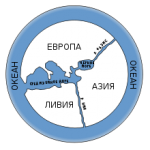
Развитие географии. Великие географические открытия
Первую, как принято считать, географическую карту составил в VI веке до нашей эры греческий ученый Анаксимандр Милетский. Земля в представлении Анаксимандра была плоской и круглой, этакий блин, окруженный мировым океаном. Центром Земли древние греки считали город Дельфы в котором хранился священный камень, называемый «омфалом» или «пупом Земли». В ІІІ веке до нашей эры древнегреческий ученый […]

Географическая оболочка Земли
Географическая оболочка – понятие условное, собирательное. В нее входят: Земная кора. Две нижние части атмосферы – тропосфера и стратосфера. Гидросфера или водная оболочка Земли. Биосфера – совокупность всего живого на Земле. Ноосфера или антропосфера – часть биосферы, связанная с разумной деятельностью человека. Разберемся с каждым пунктом по отдельности. Пункт первый – земная кора. Наша планета […]
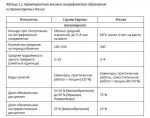
Основные модели университетской географии в странах мира
В основу этой главы положены результаты исследования, выполнявшегося в 2014-2015 гг. сотрудниками географического факультета МГУ имени М. В. Ломоносова в рамках исследовательского проекта по гранту Русского географического общества «Университетская география в современном мире». Основными исходными материалами стали результаты интервью с преподавателями европейских университетов десяти стран: Бельгии, Великобритании, Германии, Испании, Италии, Нидерландов, Польши, Финляндии, Франции, Швеции. […]
Университетская география в современном мире
Почти с первых лет основания Московского и Санкт-Петербургского университетов в них стали читаться лекции по географии, а в XIX в. были созданы первые географические кафедры. Наша страна стала одной из первых, где подготовка географов заняла достойное место в системе высшего образования, не только в столичных университетах. Развитию университетской географии в России во многом способствовала деятельность […]
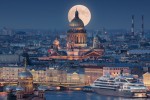
Сплав Европы и Азии
Наша Родина — Россия — расположена в двух частях света — в Европе и Азии. Россия — самая большая страна на Земле, она протянулась от Балтийского моря на западе до Тихого океана на востоке, от Арктики на севере до Кавказских гор на юге. В нашей стране живет множество народов, звучат разные языки. Здесь смешалось множество […]

Славянские страны
В современной Европе живут миллионы славян — представителей народов, говорящих на родственных языках и имеющих общее происхождение. Русские — один из славянских народов. Славянские государства — Украина, Белоруссия, Польша, Чехия, Словакия в Восточной Европе и Болгария, Сербия и Черногория, Босния и Герцеговина, Хорватия, Словения, Македония в Южной Европе — имеют древнюю историю, многие их города, […]

Великая Эллада
Древние греки, жившие несколько тысячелетий назад на Балканском полуострове и на островах Средиземного моря, называли себя эллинами, а свою страну Элладой. В современной Греции сохранилось множество античных памятников. На острове Крит в древности жили искусные мореплаватели, мастера, художники. В столичном городе Кноссе 3,5 тыс. лет назад был построен удивительный дворец — со множеством длинных переходов, […]
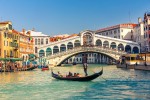
Наследники древних римлян
Италию называют музеем под открытым небом: столько здесь архитектурных шедевров. Пожалуй, самое величественное античное сооружение — амфитеатр Колизей. Кроме него, в Риме сохранились развалины форумов, термы (бани), храмы, среди них — знаменитый Пантеон (круглый храм всех богов, воздвигнутый во II в. н. э.). Однако Италия богата не только античными памятниками. Вот, например, знаменитая наклонная Пизанская […]

Высочайшие горы Европы
Европа и Азия — две части света, расположенные на одном материке — Евразии. Условную границу между ними проводят по невысокому Уралу и Кумо-Манычской впадине, лежащей к северу от заоблачных вершин Кавказа. Так что величайшими горами Европы являются Альпы, расположенные в самом сердце Европы. Не случайно их название произошло от кельтского слова «альп» — «высокая гора». […]

Прекрасная Франция
Франция протянулась с севера на юг через всю Европу — от Северного до Средиземного моря. Люди в этих краях поселились около миллиона лет назад. В древности здесь жили кельтские племена (галлы), позднее — германские, в их числе франки, давшие название современной стране (хотя французы нередко называют себя и галлами). Столица Франции Париж вырос на месте […]

Земля древних германцев
С германскими племенами, населявшими Европу на заре истории, сражались еще римляне. На территории, где живут потомки древних германцев (а это практически центр Европы), шли войны, возникали и гибли государства, строились города, соборы, замки — подлинные чудеса света. Среди достопримечательностей Германии особое место занимают готические храмы. Готические церкви возвышались над низенькими домиками, символизируя порыв к небу, […]

Родина Дон Кихота
Испания расположена на юго-западе Европы, на Пиренейском полуострове. Завоевать эту территорию, в античности населенную племенами кельтиберов, стремились еще римляне. Удалось им это с трудом, а часть вольнолюбивых племен сумела сохранить независимость и самобытную культу- ру. Их потомки — живущие сегодня в Испании баски. В начале VIII в. Пиренейский полуостров захватили мавры (арабы и берберы), они […]
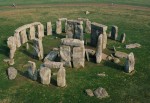
Туманный Альбион
Великобританию поэтично называют Альбионом. На языке кельтов, древнейших жителей этой страны, «альбион» означает «высокий, гористый остров». А возможно, название произошло от латинского слова «альбус» — «белый» из-за меловых утесов острова, а поскольку он часто укутан туманом, его называют еще и туманным Альбионом. Древнейшее из британских чудес света находится на юге страны — это Стоунхендж, круг […]

Христос благословляющий
Один из прекраснейших городов Южной Америки, Рио-де-Жанейро, многие годы был столицей Бразилии, пока в центре страны не построили новую столицу (ее назвали так же как и государство — Бразилиа). Выросший на берегу Атлантического океана, Рио славится прекрасными пляжами, современными небоскребами, памятниками старинной архитектуры (самый ранний из них, монастырь Сан-Бенту, датируется концом XVI в.). И все […]
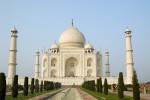
Памятник великой любви
Когда-то Индией правили императоры из династии Великих Моголов. В 1627 г. на трон взошел Шах-Джахан (в переводе его имя означает «повелитель мира»). Шах-Джахан одержал много военных побед, но не это прославило в веках его имя. Правитель очень любил свою жену Арджуманд Бану (выйдя замуж, она получила титул Мумтаз-Махал, или Тадж-Махал, «избранница двора»). Красавица Мумтаз-Махал родила […]
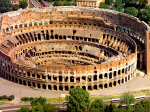
Колоссальный амфитеатр
В столице Италии Риме архитектурных памятников множество, ведь Рим был основан более 2,5 тыс. лет назад. Однако лишь один из этих памятников вошел в список новых чудес света (и, кстати, стал там единственным представителем Европы) — это Колизей, построенный в I в. н. э. Колизей — это гигантский амфитеатр. Амфитеатрами в древности называли сооружения, несколько […]